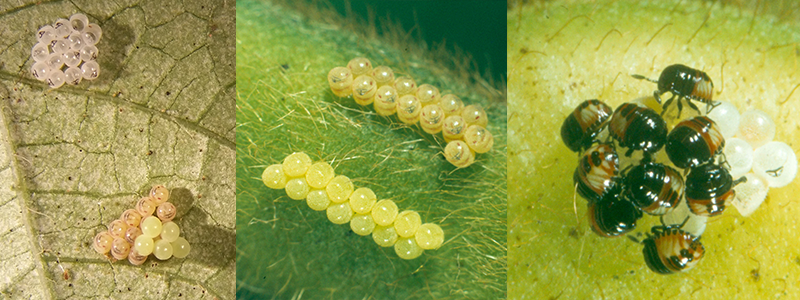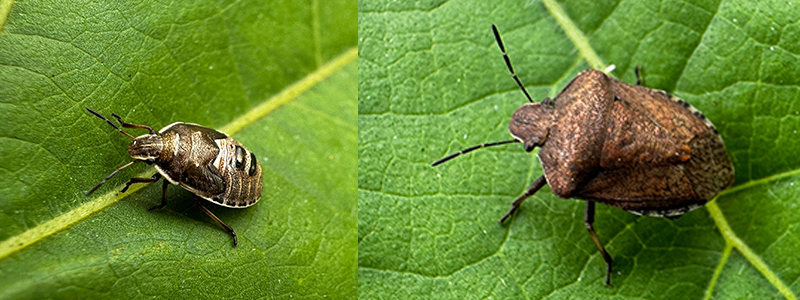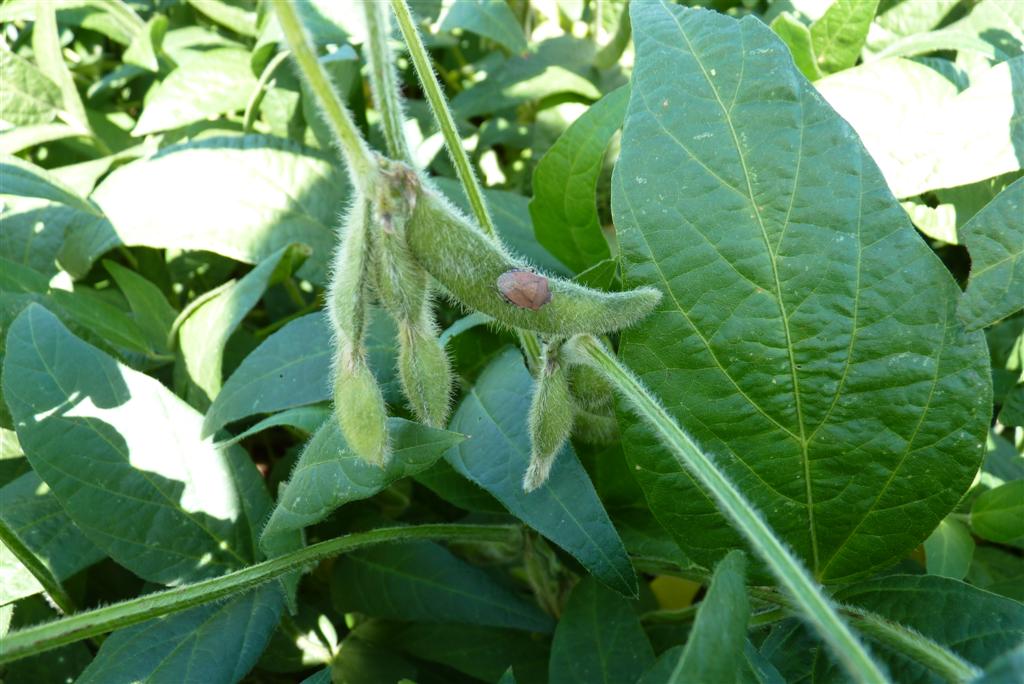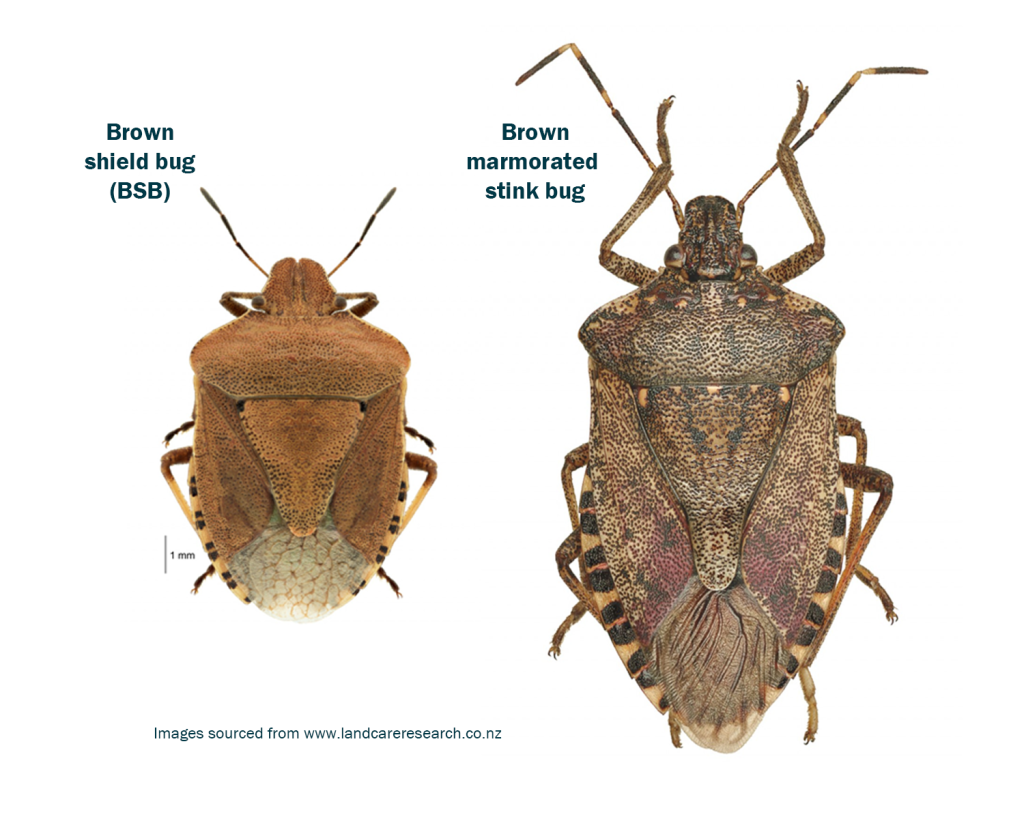High numbers of brown shield bugs (BSB, Dictyotus caenosus) have been reported in cotton fields from Hay through to Texas on the Queensland/New South Wales border.
In pulse crops, these bugs (also referred to as ‘stink’ bugs) are part of the podsucking pest complex, and can cause both yield reductions and impacts to seed quality.
Adults are about 8mm long (not including antennae), matte brown and shield shaped. Around 10-16 yellowish eggs are laid in small clumps or twin row rafts. They develop an orange tinge (or darken if parasitised). Nymphs pass through 5 instars, starting with have black heads and thoraxes, and orange/yellow abdomens with dark markings. Later instars go brownish, with a cream band at the front of the abdomen, with zebra stripes fringing it and a large central black and cream striped spot in the centre. Adults are about 8mm long and retain the zebra stripe fringing but lose the distinctive abdominal spot.

Eggs can be laid in small rafts or twin rows and turn translucent white after the nymphs have hatched.

Brown shield bug nymph (left) and adult.
Another brownish shield bug that may also be present in crops is the predatory glossy shield bug (Cermatulus nasalis). It is slightly larger and more greenish than BSB, glossy rather than matte, and while the adults appear similar, its eggs and nymphs look completely different.

Egg, nymph and adult stages of the predatory glossy shield bug.
Sampling and assessing potential damage
A beat sheet is the preferred method for sampling podsucking bugs. Also keep an eye out for the egg rafts, usually laid on stems or leaf undersides.
In summer pulses BSBs cause about 75% of the damage of the larger green vegetable bug (in cotton, the damage is about 25% GVB equivalents). The actual damage potential varies with pest stage, crop stage, and environmental conditions. An online economic threshold calculator to help you gauge the likely impact of podsucking bugs in mungbean and soybean crops is available in the Beatsheet’s ET Calculators section.

Brown shield bugs can damage seeds as the pods develop.
Incidental control
As an infrequent pest, there are no insecticides specifically registered against BSB in Australia. While it may be incidentally controlled by pesticides targeting green vegetable bug (GVB), reported experiences with this pest in pulses and cotton indicate that it is more resilient to these compounds than GVBs. Experiments by Hugh Brier in soybeans in 2009 comparing efficacy of dimethoate and clothianidin (Shield®) where both species were present, found that dimethoate at 500mL/ha provided no control of BSBs even though it reduced GVBs by 85%. Clothianidin at 250mL/ha provided a 45% reduction in BSBs compared with a 90% reduction for GVBs. In other experiments where BSB have been incidental pests, pyrethroids were found to be relatively ineffective. Similar to red-banded shield bugs (Piezodorus hybneri), BSBs are largely immune to older-style chemistry, particularly pyrethroids (Group 3A) and organophosphates (Group 1A).
Hugh Brier, who has spent over 40 years developing management strategies for sucking pests in pulses, stresses the importance of adding salt (at the rate of 5g/L of water used to make up a spray tank solution) when targeting stink bug species. Salt increases the efficacy of insecticides for sucking bug control as its presence in spray deposits triggers additional ‘probing’ behaviour by sucking bugs, resulting in better product uptake and kill.
Natural enemies will not be much help
Unfortunately, natural enemies are unlikely to provide sufficient biological control to significantly reduce populations of stink bug species such as BSB over the short term. A number of parasitoids can attack the egg and late nymph or adult stages but are unlikely to influence pest abundance in the field. Similarly, there are very few effective predators of shield bugs as these insects are hard bodied and able to defend themselves with defensive secretions (earning their ‘stink bug’ name). Therefore, if podsucking bugs are causing economic damage, management should focus on judicious insecticide use (keeping in mind that none of the GVB-registered options are soft and subsequent flaring of SLW, mites or aphids is likely).

Parasitised eggs turn black before the wasp emerges (green vegetable bug eggs pictured).
Be biosecurity aware
The current influx of brown bugs been confirmed as our endemic species Dictyotus caenosus. However, the exotic brown marmorated stink bug (Halyomorpha halys), although successfully intercepted at Australia’s ports to date, is likely to eventually reach cropping areas. If you encounter unusual brown stink bugs in your crop, particularly if they are 50% larger than BSB, more patterned with a narrower head and pale stripes on their antennae, please call the Exotic Plant Pest Hotline: 1800 084 881.
Ideally, collect a sample or take a few high-resolution images with your smart phone. There are a large number of brown coloured shield bugs that occur in Australia that look similar to marmorated stink bugs but it never hurts to confirm the identification of something suspicious.
Adapted from CottonInfo eNews of 19 January 2024 (original article by Paul Grundy). Photos of bug life stages by Hugh Brier, Joe Wessels and Paul Grundy.

